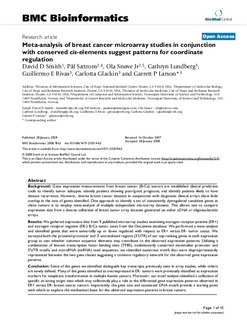| dc.contributor.author | Smith, DD | |
| dc.contributor.author | Sætrom, Pål | |
| dc.contributor.author | Snøve, Ola | |
| dc.contributor.author | Lundberg, C | |
| dc.contributor.author | Rivas, GE | |
| dc.contributor.author | Glackin, C | |
| dc.contributor.author | Larson, GP | |
| dc.date.accessioned | 2015-09-21T11:29:36Z | |
| dc.date.accessioned | 2016-04-06T14:14:37Z | |
| dc.date.available | 2015-09-21T11:29:36Z | |
| dc.date.available | 2016-04-06T14:14:37Z | |
| dc.date.issued | 2008 | |
| dc.identifier.citation | BMC Bioinformatics 2008, 9 | nb_NO |
| dc.identifier.issn | 1471-2105 | |
| dc.identifier.uri | http://hdl.handle.net/11250/2384340 | |
| dc.description.abstract | Background: Gene expression measurements from breast cancer (BrCa) tumors are established clinical predictive
tools to identify tumor subtypes, identify patients showing poor/good prognosis, and identify patients likely to have
disease recurrence. However, diverse breast cancer datasets in conjunction with diagnostic clinical arrays show little
overlap in the sets of genes identified. One approach to identify a set of consistently dysregulated candidate genes in
these tumors is to employ meta-analysis of multiple independent microarray datasets. This allows one to compare
expression data from a diverse collection of breast tumor array datasets generated on either cDNA or oligonucleotide
arrays.
Results: We gathered expression data from 9 published microarray studies examining estrogen receptor positive (ER+)
and estrogen receptor negative (ER-) BrCa tumor cases from the Oncomine database. We performed a meta-analysis
and identified genes that were universally up or down regulated with respect to ER+ versus ER- tumor status. We
surveyed both the proximal promoter and 3' untranslated regions (3'UTR) of our top-ranking genes in each expression
group to test whether common sequence elements may contribute to the observed expression patterns. Utilizing a
combination of known transcription factor binding sites (TFBS), evolutionarily conserved mammalian promoter and
3'UTR motifs, and microRNA (miRNA) seed sequences, we identified numerous motifs that were disproportionately
represented between the two gene classes suggesting a common regulatory network for the observed gene expression
patterns.
Conclusion: Some of the genes we identified distinguish key transcripts previously seen in array studies, while others
are newly defined. Many of the genes identified as overexpressed in ER- tumors were previously identified as expression
markers for neoplastic transformation in multiple human cancers. Moreover, our motif analysis identified a collection of
specific cis-acting target sites which may collectively play a role in the differential gene expression patterns observed in
ER+ versus ER- breast cancer tumors. Importantly, the gene sets and associated DNA motifs provide a starting point
with which to explore the mechanistic basis for the observed expression patterns in breast tumors. | nb_NO |
| dc.language.iso | eng | nb_NO |
| dc.publisher | BioMed Central | nb_NO |
| dc.rights | Navngivelse 3.0 Norge | * |
| dc.rights.uri | http://creativecommons.org/licenses/by/3.0/no/ | * |
| dc.title | Meta-analysis of breast cancer microarray studies in conjunction with conserved cis-elements suggest patterns for coordinate regulation | nb_NO |
| dc.type | Journal article | nb_NO |
| dc.type | Peer reviewed | nb_NO |
| dc.date.updated | 2015-09-21T11:29:36Z | |
| dc.source.volume | 9 | nb_NO |
| dc.source.journal | BMC Bioinformatics | nb_NO |
| dc.identifier.doi | 10.1186/1471-2105-9-63 | |
| dc.identifier.cristin | 362768 | |
| dc.description.localcode | © Smith et al; licensee BioMed Central Ltd. 2008. This article is published under license to BioMed Central Ltd. This is an Open Access article distributed under the terms of the Creative Commons Attribution License (http://creativecommons.org/licenses/by/2.0), which permits unrestricted use, distribution, and reproduction in any medium, provided the original work is properly cited. | nb_NO |

